 W
WA carbine is a long-barreled firearm whose barrel is shorter than that of a standard rifle or musket. Most carbines are shortened versions of full-length rifles, shooting the same type of ammunition, while others fire generally lower-powered ammunition, including types designed for pistols.
 W
WThe AK-102 is a shortened carbine version of the AK-101 rifle, which in turn was derived from the original AK-47 design and its AK-74 successor. The AK-102, AK-104, and AK-105 are very similar in design, the only difference being the caliber and corresponding magazine type. The AK-102 is chambered to fire 5.56×45mm NATO ammunition, and is designed entirely for export purposes.
 W
WThe AK-104 is a carbine variant of the AK-103. The AK-102, AK-105 and AK-104 are very similar in design, the differences being the caliber, functions and corresponding magazine types. The AK-104 is chambered to fire 7.62×39mm ammunition and thusly feeds from any standard 7.62x39 AK pattern magazine.
 W
WThe AK-105 is a shortened carbine version of the AK-74M rifle, which in turn was derived from the original AK-47 design and its successor, the AK-74. The AK-102, AK-104, and AK-105 are very similar in design, the only difference being the caliber and corresponding magazine type. The AK-105 is chambered to fire 5.45×39mm ammunition.
 W
WThe AK-205 is a carbine chambered in 5.45×39mm. The AK-205 is basically a modernized version of the AK-105, which in turn is a shortened carbine version of the AK-74M. The AK-205 was originally known as AK-105M before being renamed ''AK-205'' in 2018. The AK-205, AK-202 and AK-204 are very similar in design, the only difference being the caliber and magazine type.
 W
WThe AKMSU is the name attributed to a compact carbine derived from the Soviet AKM, chambered in 7.62×39mm. The carbine was commonly thought to be a Soviet prototype weapon, but evidence suggests that the carbine was not actually of Soviet origin, and was instead a custom-made weapon misattributed as a Soviet weapon.
 W
WThe Amogh Carbine is a select-fire personal defense weapon designed & manufactured by Ordnance Factories Board. It is a derivative of the Excalibur rifle, which in turn is a development of the INSAS rifle.
 W
WThe Benelli MR1 is a rifle developed and manufactured by the Benelli Armi SpA of Italy.
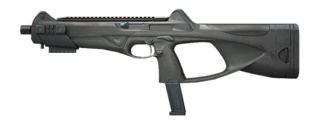 W
WThe Beretta Cx4 Storm is a pistol-calibre semi-automatic carbine aimed at the sporting, personal defense and law enforcement markets. It is available in two models: one that accepts 92/96 magazines, and one that accepts Px4 series magazines, each available in 9×19mm Parabellum, .40 S&W, .45 ACP, and 9×21mm.
 W
WThe Berthier rifles and carbines were a family of bolt-action small arms in 8mm Lebel, used in the French Army from the 1890s to the beginning of World War II (1940).
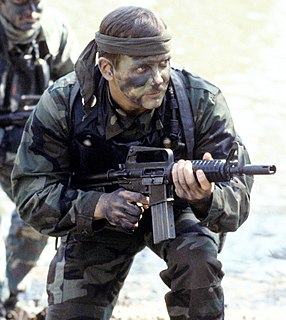 W
WThe Colt Automatic Rifle-15 or CAR-15 was a family of M16 rifle based firearms marketed by Colt in the 1960s and early 1970s. However, the term "CAR-15" is most commonly associated with the Colt Commando (AKA: XM177); these select-fire carbines have ultrashort 10.5-inch (270 mm) and 11.5-inch (290 mm) barrels with over-sized flash suppressors.
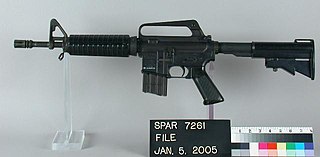 W
WThe CAR-15 XM177 or CAR-15 Commando was a part of the CAR-15 Military Weapons System designed in 1966 in response to the US military's desire for a compact M16 variant to improve on the inadequacies of earlier shortened M16 types.
 W
WThe Colt 933 is a compact carbine based on the AR-15 and M16 rifle produced by Colt starting in 1995. Due to their compact size, the short-barreled Colt 933 continues to be used by various US Special Forces and by some foreign forces, including Israeli Special Forces.
 W
WThe Colt Lightning Carbine or Colt Lightning Rifle was a slide-action (pump-action) rifle manufactured by Colt from 1884 to 1904 and was originally chambered in .44-40 caliber. Colt eventually made the Lightning Rifle in three different frame sizes, to accommodate a wide range of cartridges, from .22 Short caliber and .38-40 to .50-95 Express. Its profile resembles the pump-action rimfire rifles made by the Winchester Repeating Arms Company and Remington Arms. The Lightning saw use as a sporting arm in America and was adopted for use by the San Francisco Police Department, but was never as popular or as reliable as the various lever-action rifles of its day.
 W
WThe .30 Kiraly-Cristóbal Carbine, also known as the San Cristóbal or Cristóbal Automatic Rifle was manufactured by the Dominican Republic’s Armería San Cristóbal Weapon Factory.
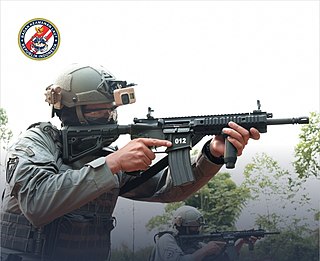 W
WDasan Machineries K16 is a 5.56×45mm NATO selective fire submachine gun based on DSAR15PC, which is a modified CQB variant of DSAR15P designed and manufactured by Dasan Machineries. DSAR15PC was selected on June 23, 2020 to replace K1A submachine gun in service in the Republic of Korea Army Special Warfare Command after competing against S&T Motiv STC-16. The Republic of Korea Armed Forces classifies K16 as submachine gun for same reason as K1A while its general characteristic is closer to assault rifle or carbine. K16 will undergo 3 years of development and 1 year of feasibility study in between 2020 and 2024, and start mass-producing by 2024. However, in June 2021, the DSAR-15PC was cancelled as the base model for the special operational submachine gun development project due to allegations of leaking military secrets by a former manufacturer's executive. As a result, the project returned to square one, forcing the selection of other firearms.
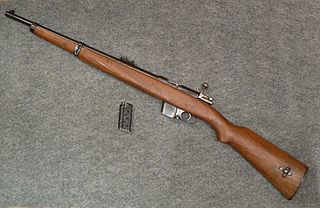 W
WThe Destroyer Carbine is a small bolt action carbine usually chambered for the 9 x 23 mm Largo cartridge. It was used by Spanish police and prison services, including the Guardia Civil from the mid-1930s until the late 1960s, replacing the El Tigre Rifle. It continued the tradition, started in the 1890s, of issuing police units with a short, handy, repeating carbine in pistol ammunition calibre.
 W
WThe karabinek wz. 1996 Mini-Beryl is a Polish compact assault rifle (carbine) derived from the FB Beryl service rifle and chambered for 5.56×45mm. It was developed in parallel with the wz. 1996 Beryl by the "Łucznik" Arms Factory in Radom and introduced into service with the Polish Armed Forces in 1997 as the 5,56 mm karabinek krotki wz. 1996.
 W
WThe Gallager carbine is an American black powder breechloading rifle produced in the American Civil War.
 W
WThe MP5 is a 9x19mm Parabellum submachine gun, developed in the 1960s by a team of engineers from the German small arms manufacturer Heckler & Koch GmbH (H&K) of Oberndorf am Neckar. There are over 100 variants and clones of the MP5, including some semi-automatic versions.
 W
WThe Karabiner 98 kurz, often abbreviated Karabiner 98k, Kar98k or K98k and also incorrectly sometimes referred to as a K98, is a bolt-action rifle chambered for the 7.92×57mm Mauser cartridge. It was adopted on 21 June 1935 as the standard service rifle by the German Wehrmacht. It was one of the final developments in the long line of Mauser military rifles.
 W
WThe KRISS Vector is a series of weapons based upon the parent submachine gun design developed by the American company KRISS USA, formerly Transformational Defense Industries (TDI). They use an unconventional delayed blowback system combined with in-line design to reduce perceived recoil and muzzle climb.
 W
WThe KS-23 is a Soviet shotgun, although because it uses a rifled barrel it is officially designated by the Russian military as a carbine. KS stands for Karabin Spetsialniy, "Special Carbine". It is renowned for its large caliber, firing a 23 mm round, equating to 6.27 gauge using the British and American standards of shotgun gauges and approximately 4 gauge using the current European standards, making it the largest-bore shotgun in use today.
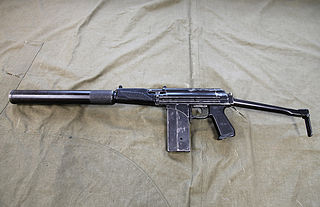 W
WA carbine, from French carabine, is a long arm firearm but with a shorter barrel than a rifle or musket. Many carbines are shortened versions of full-length rifles, shooting the same ammunition, while others fire lower-powered ammunition, including types designed for pistols.
 W
WThe M1 carbine is a lightweight semi-automatic carbine that was a standard firearm for the U.S. military during World War II, the Korean War and the Vietnam War. The M1 carbine was produced in several variants and was widely used by paramilitary and police forces around the world, and also became a popular civilian firearm after World War II.
 W
WThe M4 Carbine is a 5.56×45mm NATO, air-cooled, gas-operated, direct impingement, magazine-fed, select fire carbine. It has a 14.5 in (370 mm) barrel and a telescoping stock. It is essentially a lighter and shorter variant of the M16A2 assault rifle.
 W
WThe .45 Reising submachine gun was manufactured by Harrington & Richardson (H&R) Arms Company in Worcester, Massachusetts, USA, and was designed and patented by Eugene Reising in 1940. The three versions of the weapon were the Model 50, the folding stock Model 55, and the semiautomatic Model 60 rifle. Over 100,000 Reisings were ordered during World War II, and were initially used by the United States Navy, Marine Corps, and the United States Coast Guard, though some were shipped to Canadian, Soviet, and other allied forces to fight the Axis powers.
 W
WThe Marlin Model 1894 is a lever-action repeating rifle introduced in 1894 by the Marlin Firearms Company of North Haven, Connecticut. At its introduction the rifle came with a 24-inch barrel and was chambered for a variety of pistol rounds such as .25-20 Winchester, .32-20 Winchester, .38-40, and .44-40. Variants in other chamberings remain in production today.
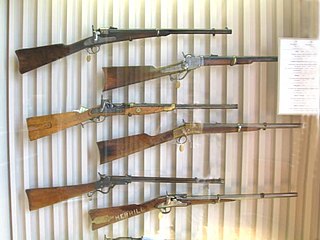 W
WThe Merrill carbine was a breechloader firearm designed by Baltimore, Maryland gunsmith and inventor James H. Merrill. It was one of several firearms either manufactured or altered by Merrill in fulfillment of contracts with the Union government during the U.S. Civil War.
 W
WThe QBZ-191 Automatic Rifle is a Chinese assault rifle designed and manufactured by Norinco, as a new-generation service rifle for the People's Liberation Army (PLA) and People's Armed Police (PAP). The rifle's designation "QBZ" stands for "light weapon-(Qīng Wŭqì) rifle-(Bùqiāng) automatic-(Zìdòng)". The rifle was formally revealed at the 70th Anniversary National Day military parade on October 1, 2019, carried by troopers of the PLA Ground Force (PLAGF) and People's Armed Police (PAP).
 W
WThe Ruger PC-9 Pistol Caliber Carbine is a blowback centerfire semi-automatic pistol-caliber carbine manufactured by Sturm, Ruger & Co., designed as a companion to certain Ruger Pistol-Series semi-automatic pistols, using the same 9 mm Parabellum and .40 S&W caliber cartridges and magazines of the P-Series pistols.
 W
WThe SIG MCX is a family of firearms designed and manufactured by SIG Sauer, produced in both selective fire and semi-automatic only models, and features a short-stroke gas piston system, which is inherited from the earlier SIG MPX submachine gun. The MCX is available in rifle, carbine, short-barreled rifle, and pistol configurations.
 W
WThe SKS is a semi-automatic carbine chambered for the 7.62×39mm round, designed in 1943 by Sergei Gavrilovich Simonov. A reliable, simply designed, and relatively inexpensive weapon, the SKS was first produced in the Soviet Union but later widely exported and manufactured by various nations. Its distinguishing characteristics include a permanently attached folding bayonet and a hinged, fixed magazine. As the SKS lacked select-fire capability and its magazine was limited to ten rounds, it was rendered obsolete in the Soviet Armed Forces by the introduction of the AK-47 in the 1950s. Nevertheless, SKS carbines continued to see service with the Soviet Border Troops, Internal Troops, and second-line and reserve army units for decades.
 W
WThe Special Operations Assault Rifle (SOAR) is an assault rifle manufactured by FERFRANS and designed as an improvement of the M4 carbine.
 W
WThe Starr carbine was a breechloading single-shot rifle used by the United States Army. Designed in 1858, the Starr was primarily used by cavalry soldiers in the American Civil War.
 W
WThe T86 rifle is a gas-operated, magazine-fed, air-cooled assault rifle. It is the second original rifle design conducted by the 205th Armory of Combined Service Forces, Republic of China (Taiwan). Though it saw limited production and service after a protracted development process, it became the basis of the T91 Assault Rifle currently in volume production for the ROC armed forces.
 W
WThe T91 rifle is produced by the 205th Armory of the Republic of China Ministry of National Defense. It is based on the proven T86 assault rifle, incorporating features from the M16 and AR-18 rifles with more modern features. The T91 is lighter and shorter than the T65 it replaces and has a 3-position telescoping stock to allow adjustment based on individual requirements.
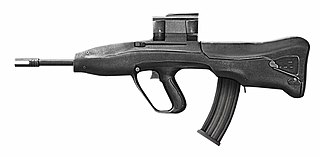 W
WThe Vektor CR-21 is a prototype South African assault rifle chambered for 5.56×45mm NATO ammunition. It was designed by Denel Land Systems as a possible replacement for the South African National Defence Force's current R4 assault rifle, however Denel Land Systems has since shifted focus to offering an upgraded R4 assault rifle to the SANDF instead.
 W
WThe Wieger StG-940 was an East German series of assault rifles loosely based upon the Kalashnikov AK-74. The StG-940 was chambered in 5.56×45mm NATO and the StG-942 in 5.45×39mm M74.
 W
WThe Zastava M85 is a carbine designed and produced by then Yugoslavian Zastava Arms. It is a shortened version of the original rifle, the Zastava M80, which is itself successor to the Zastava M70 assault rifle. The M85 is practically same as the carbine version of the M70, the Zastava M92, the only difference being in caliber, and in this case, the magazine design, as same as with original rifles, the M70 and M80.
 W
WThe Zastava M92 is a carbine developed and manufactured by Serbian Zastava Arms. It is nearly identical to the Zastava M85 carbine; the only differences between the two are caliber and, correspondingly, magazine design. The M92 is a shortened version of the Zastava M70 assault rifle, which is a modified copy of the Soviet AKM assault rifle.